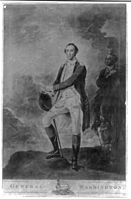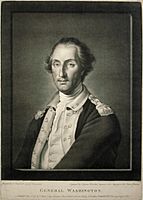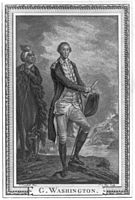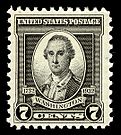George Washington (Trumbull) facts for kids
Quick facts for kids George Washington |
|
|---|---|
| George Washington and William Lee | |
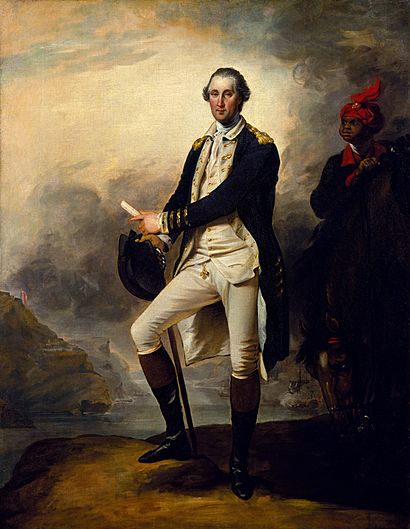 |
|
| Artist | John Trumbull |
| Year | 1780 |
| Medium | oil on canvas |
| Dimensions | 91.4 cm × 71.1 cm (36 in × 28 in) |
| Location | Metropolitan Museum of Art, New York City |
The painting George Washington, also known as George Washington and William Lee, is a famous portrait. It was painted in 1780 by American artist John Trumbull. This was during the American Revolutionary War.
The painting shows General George Washington standing tall. Next to him is his trusted assistant, William Lee. They are looking out over the Hudson River in New York. In the background, you can see West Point and some ships.
John Trumbull used to work for Washington. He painted this picture from his memory. He was studying art in London at the time. The painting is about 36 by 28 inches. You can see it today at the Metropolitan Museum of Art in New York City.
Contents
How the Painting Was Made
John Trumbull was a soldier before he became a painter. He served as an aide-de-camp (a personal assistant) to General Washington. This was in 1775. Later, he became a colonel. He left the army in 1777.
After leaving the army, Trumbull went back to painting. He traveled to London in 1780 to study art. His teacher was a famous artist named Benjamin West. Trumbull painted this portrait of Washington from his memory. He likely gave it to a Dutch family, the de Neufvilles.
In November 1780, Trumbull was arrested in London. This was because of news about Benedict Arnold, a general who betrayed the American cause. Trumbull was held for almost seven months. He was released in June 1781. He then had to leave England.
Trumbull went to Amsterdam. From there, he planned his trip back home. He sailed on a ship called the South Carolina. He arrived back in Boston in January 1782.
Journey of the Painting
The painting stayed with the de Neufville family for many years. They owned it until 1890. Then, it was sold through art dealers. An art dealer from New York, Edward G. Kennedy, bought it.
By 1908, the painting was owned by Charles Allen Munn. He was a collector. When he passed away in 1924, he gave the painting to the Metropolitan Museum of Art. That is where it is today.
What the Painting Shows
In the painting, Washington wears his full military uniform. He has a blue coat over a light brown vest and pants. He stands brightly lit in the middle of a landscape. He is on a hill overlooking the Hudson River.
On the left side in the background, you can see West Point. A red and white striped flag is flying there. Washington holds a hat, a sword, and a rolled-up document.
A Black servant is shown with Washington's horse. This person is usually known as William "Billy" Lee. He wears a red turban. In the distance, you can see smoke rising from ships on the river.
Other artists' works might have influenced Trumbull. For example, Charles Willson Peale painted a portrait of Washington around 1776. Trumbull had copied this painting before. The way Washington is shown with his horse and assistant is similar to older paintings. One example is Charles I at the Hunt by Anthony van Dyck.
Other Artworks Inspired by This Painting
The painting inspired other artists to create their own versions. A British artist named Valentine Green made an engraving of it. An engraving is a print made from a metal plate. He called his version General Washington. This was published in 1781.
Green made another portrait in 1783. It showed only the top half of Washington. In 1782, another artist named Jacques Le Roy also made an engraving. His version was called G. Washington. The image in his engraving was reversed.
Gallery
-
Charles I at the Hunt, Anthony van Dyck, c. 1635, Louvre
-
George Washington, Charles Willson Peale, c. 1776, Brooklyn Museum
Legacy of the Painting
This painting of George Washington has been used in other ways. In 1932, a seven-cent postage stamp was made. It featured Washington based on this painting. The U.S. Post Office issued it.
In 1925, the painting was shown on the first page of The Metropolitan Museum of Art Bulletin. This is a magazine from the museum. An article inside described it.




